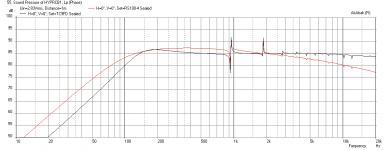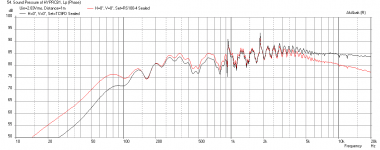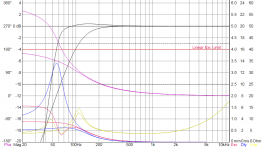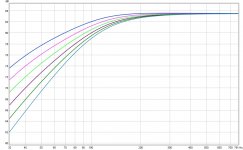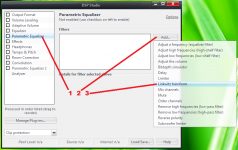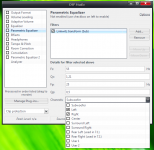I ran some sealed box sims of the TC9FD and RS100-4 for a 3 liter (Q=0.7) chamber and I adjusted the resonant characteristic chamber "length" to 1.57x of the edge length "a" (this was done to allow an empirical adjustment of a parameter to see if I could capture the two resonant peaks/dips at 920Hz and 2kHz). For purposes of calculating baffle step and diffraction effects, I made the baffle width and height equal to a baffle width of 1.3x a. I placed the speaker at height of 36in from floor and 90in from nearest wall for reflections.
Here is the sim with no reflections or baffle step effects (black = TC9FD, red=RS100-4):

Here is the sim with effects of reflections and diffraction - obviously, these are going to be much worse than reality as this assumes a hard sharp edge baffle whereas the reality is smoother 45 deg angle step, and floor/wall bounce may be different due to absorbtion/reflection coefs - but shows the potential for why the measurement is wiggly - an anechoic or outdoor measurement up high will isolate this:
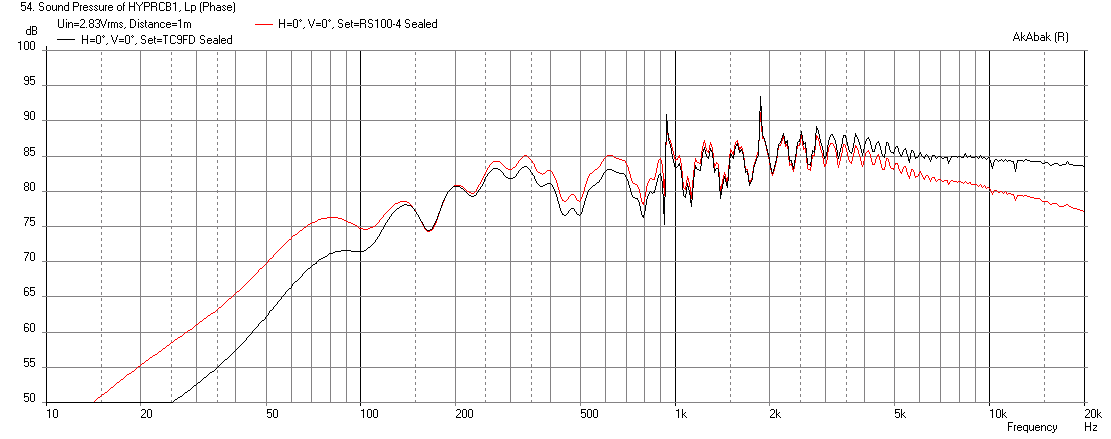
Here is the previous measurement:
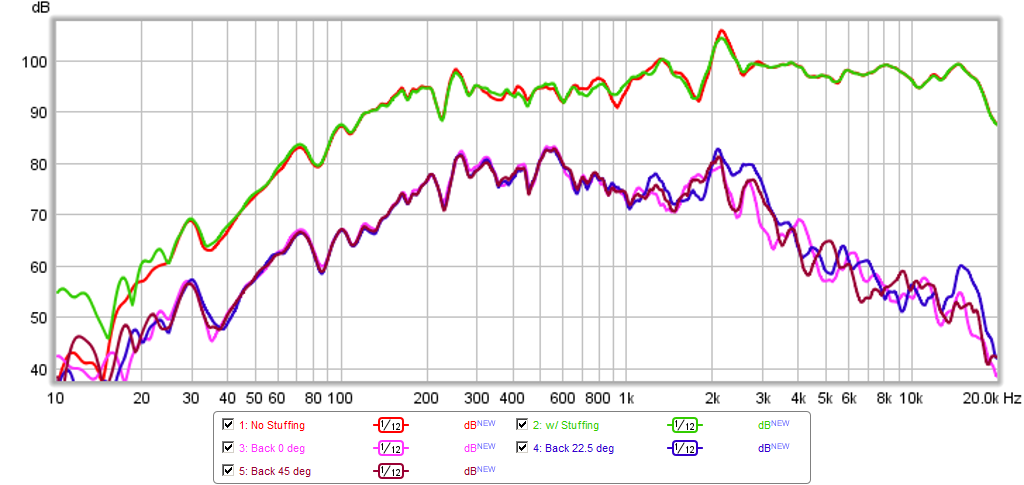
Here is predicted cone displacement at 2.83v:

Here is the sim with no reflections or baffle step effects (black = TC9FD, red=RS100-4):

Here is the sim with effects of reflections and diffraction - obviously, these are going to be much worse than reality as this assumes a hard sharp edge baffle whereas the reality is smoother 45 deg angle step, and floor/wall bounce may be different due to absorbtion/reflection coefs - but shows the potential for why the measurement is wiggly - an anechoic or outdoor measurement up high will isolate this:

Here is the previous measurement:

Here is predicted cone displacement at 2.83v:

Attachments
Last edited:
This will be my first aluminum cone driver and first one with a phase plug. The magnet looks like it is about same diameter as the driver cutout hole.
Gmad, did you apply EQ like Linkwitz transform to extend the bass in a sealed cabinet? Because a sealed box sim predicts no lower than 150Hz before bass starts falling off.
This was my first experience with an aluminum cone driver as well. This driver also comes in a paper version (RS100P-4). My speaker design software models an F3 of 109 hz with a standard sealed alignment based on the published specs (RS100-4).
When I first started playing around with the speaker, I was boosting 55hz (foobar eq) by about 9 or 10db. Ever since I set up a stereo pair and measured from the sofa, I just let my room correction software do its thing. Call it a combination of lucky room placement and improved lows of the hypercube enclosure , but I get usable response to ~32hz . Since I don't listen very loud, I can actually live without a sub. I wouldn't believe it myself if I didn't experience it first hand.
I was boosting 55hz (foobar eq) by about 9 or 10db.
Gmad,
Is that a low-shelf boost or peak boost at 55Hz? What was the Q? Trying to replicate this via the parametric EQ (PEQ) on miniDSP. Need type of EQ (shelf or peak, amplitude, freq center (Hz), Q).
Thanks,
X
Post 21
Thanks xrk971 at post 21 your description of the three first plot really increased my learning curve what happens when measuring real world. At same think predicted sim picture two compared real measurement at picture three not bad, example a 8-9dB fall from 200 down to 100Hz is at both. Same volume condition RS100 extend lowend.
Thanks xrk971 at post 21 your description of the three first plot really increased my learning curve what happens when measuring real world. At same think predicted sim picture two compared real measurement at picture three not bad, example a 8-9dB fall from 200 down to 100Hz is at both. Same volume condition RS100 extend lowend.
..........I get usable response to ~32hz . Since I don't listen very loud, I can actually live without a sub. I wouldn't believe it myself if I didn't experience it first hand.
.....🙂.....great.
Here sim software agree, butterworth box high pass Q 0,7071 F3=109,4Hz.
Thanks xrk971 at post 21 your description of the three first plot really increased my learning curve what happens when measuring real world. At same think predicted sim picture two compared real measurement at picture three not bad, example a 8-9dB fall from 200 down to 100Hz is at both. Same volume condition RS100 extend lowend.
The model also predicts the measured -5dB baffle step loss from 2kHz down to 600Hz.
The model also predicts the measured -5dB baffle step loss from 2kHz down to 600Hz.
Great software and operator, is the model/profile you use in the program one you have calculated/experienced yourself to reach those real world predictions.
For fun here RS100-4 sealed 1,859 liter verse bass reflex 2,9 liter what i think maybe is called QB3 alignment.
The math found this domain somewhere, in sealed software mode take note the volume at Q 0,7071 and x 1,56 = new volume to bass reflex box, Still in sealed software mode set the new volume as to be used for bass reflex now note new box resonance Fsc and divide that 1,56 = Tuning frequency for bass reflex box. Set the software to bass reflex box mode and use the calculated volume and tuning.
EDIT: In bass reflex box RS100 like 150Hz XO in a FAST system.
Attachments
Last edited:
Gmad,
Is that a low-shelf boost or peak boost at 55Hz? What was the Q? Trying to replicate this via the parametric EQ (PEQ) on miniDSP. Need type of EQ (shelf or peak, amplitude, freq center (Hz), Q).
Thanks,
X
Since it was the lowest slider on the eq, it was acting as a shelf. It was a weak attempt at approximating a Linkwitz transform and only served to give me an idea of what the speakers could do. When I get home this evening, I'll be happy to work up the numbers that you're looking for. --Greg
Great software and operator, is the model/profile you use in the program one you have calculated/experienced yourself to reach those real world predictions.
The Akabak software is pretty good and in my experience does a pretty good job with baffle step and basic edge diffraction from rectangular hard edge baffles and wall/floor bounce. The model allows for the two cabinets to be different size with vertical and depth offsets for time alignment, and I can apply different filters for each driver.
I am already modeling the 2-way HyperFAST with the as-built dimensions and drivers, and am finding out that the optimal XO point is asymmetric for the LF and HF drivers.
Here is the predicted response for a symmetric -24dB/oct XO at 300Hz - I observed the hump at XO point in reality. I have applied a BSC (0.5mH + 5ohm) for the TC9FD but not performed any Linkwitz transform to extend the bass of the woofer. Pretty pathetic bass extension without EQ, makes sense given the rather low Qts and powerful motor. This driver is asking for a vented cabinet or a Linkwitz transform in sealed:
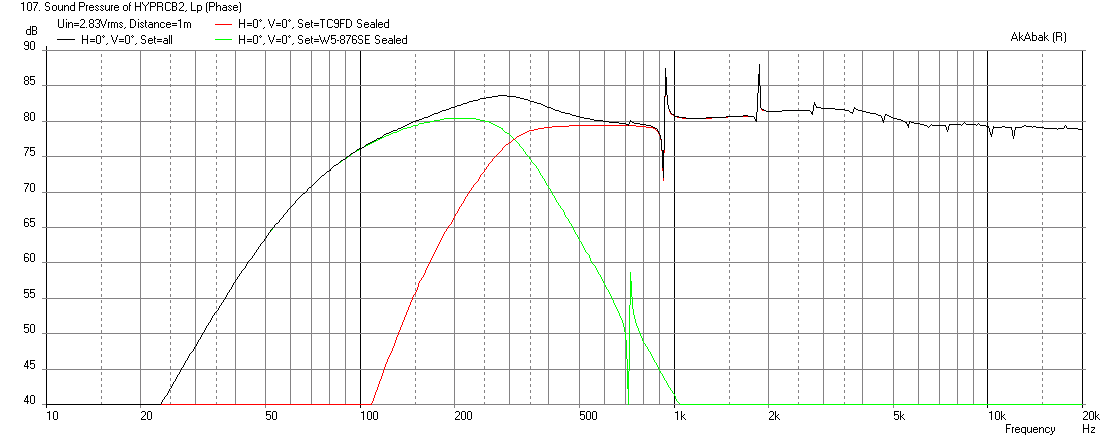
Here is the same model but with the woofer HPF at 240Hz and the TC9FD HPF at 300Hz - less of a XO hump:
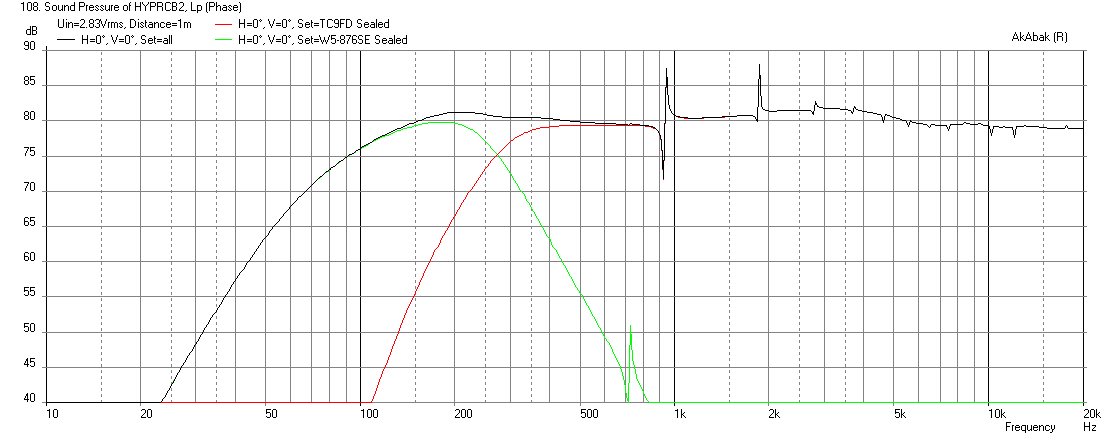
Here is the corresponding cone displacement, note the ample room left for EQ'ing the bottom end xmax is 5 mm):

Now I have added a 2in dia x 8in long rear-firing vent on the woofer chamber:
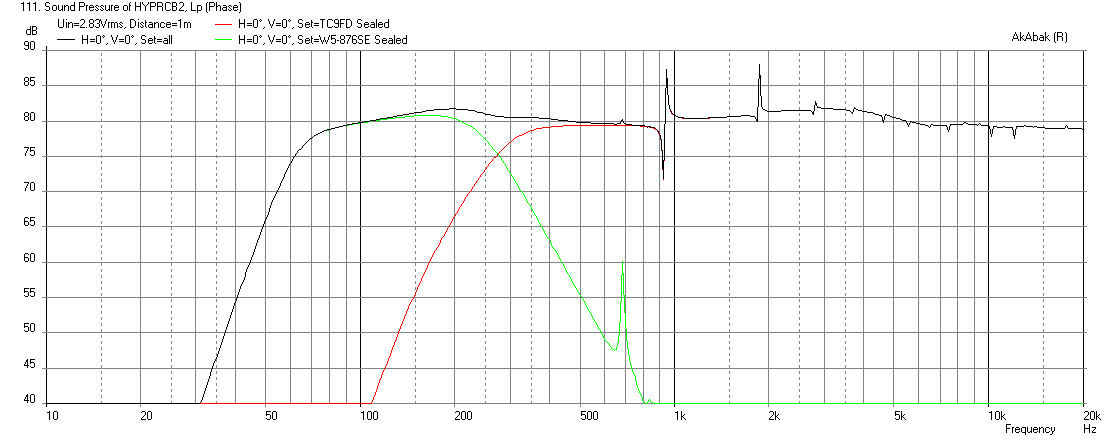
Here is corresponding cone displacement:

Looks like it can have nice mid 60Hz bass extension - which isn't much better than what the RS100-4 can do, but of course the RS100-4 will have much more cone travel and higher HD.
Attachments
-
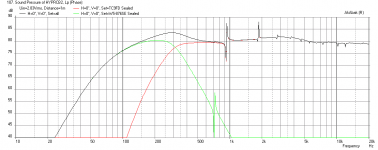 HyperFAST-TC9FD-W5-976SE-Sealed-Freq-1m.png37.1 KB · Views: 578
HyperFAST-TC9FD-W5-976SE-Sealed-Freq-1m.png37.1 KB · Views: 578 -
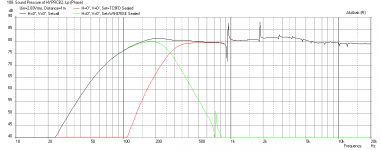 HyperFAST-TC9FD-W5-976SE-Sealed-Freq-1m-240Hz.png20.1 KB · Views: 568
HyperFAST-TC9FD-W5-976SE-Sealed-Freq-1m-240Hz.png20.1 KB · Views: 568 -
 HyperFAST-TC9FD-W5-976SE-Sealed-Displ-240Hz.png26.8 KB · Views: 572
HyperFAST-TC9FD-W5-976SE-Sealed-Displ-240Hz.png26.8 KB · Views: 572 -
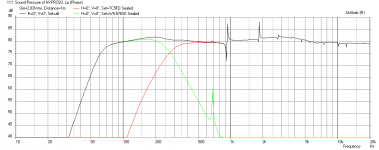 HyperFAST-TC9FD-W5-976SE-BR-Freq-240Hz.png36 KB · Views: 570
HyperFAST-TC9FD-W5-976SE-BR-Freq-240Hz.png36 KB · Views: 570 -
 HyperFAST-TC9FD-W5-976SE-BR-Displ-240Hz.png14.4 KB · Views: 584
HyperFAST-TC9FD-W5-976SE-BR-Displ-240Hz.png14.4 KB · Views: 584
Last edited:
Hi X,
Here is what the RS100-4 response should look like with 0-15db (in 3db increments) low shelf boost centered at 55hz with a Q of 0.7.
Also, you might be interested in this (apologies if you already know about it):
Linkwitz Transform
--Greg
Here is what the RS100-4 response should look like with 0-15db (in 3db increments) low shelf boost centered at 55hz with a Q of 0.7.
Also, you might be interested in this (apologies if you already know about it):
Linkwitz Transform
--Greg
Attachments
Thanks for the link on the Linkwitz transform for miniDSP. That is exactly what I needed to calculate the bi quad coefs.
Linkwitz transform
I used the miniDSP provided spreadsheet to calculate the biquad coefs for a Linkwitz transform based on the measured fb=120Hz and Q=0.71, transformed to a new f=50Hz and Q=0.71.
Here are the Linkwitz transform bi-quad coefs for the W5-876SE in a 6in edge Hypercube with moderate stuffing:
Here is the raw response of the woofer (blue), and with the Linkwitz transform applied (red), this is measured 2in away from the cone per the recommendation in the miniDSP instructions:
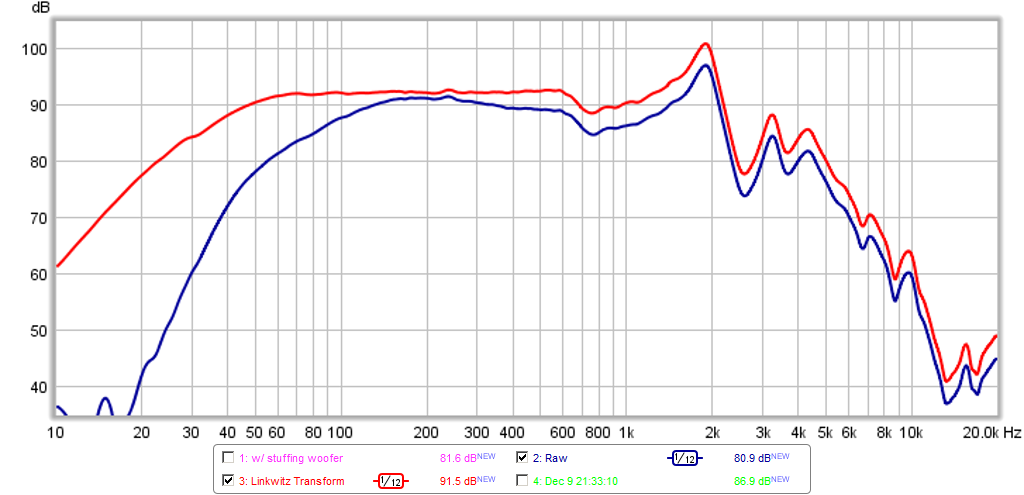
Here is the new resulting XO using a 240Hz LP on the woofer and 300Hz HP on the fullrange per the Akabak sim. Note that the -3dB point is about 43Hz which is excellent considering it was 120Hz before. The highs are little depressed since the mic was in between the TC9FD and the W5876SE at 8in away so it's a little off axis:
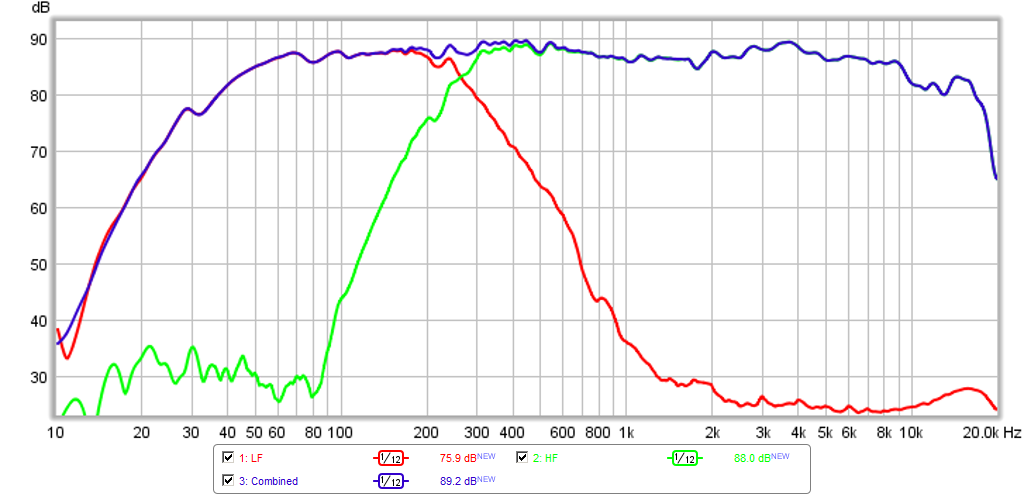
Here is the corresponding measured minimum phase:
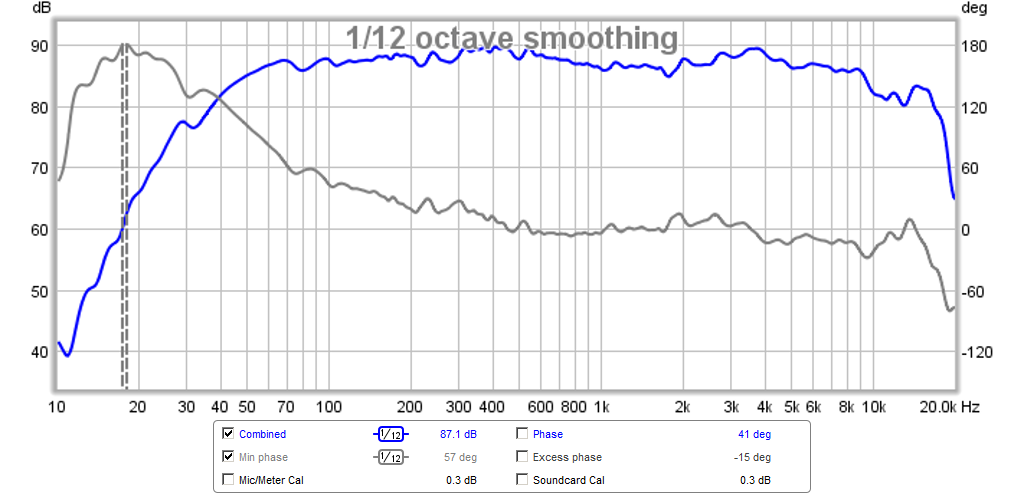
This is the measured impulse response:
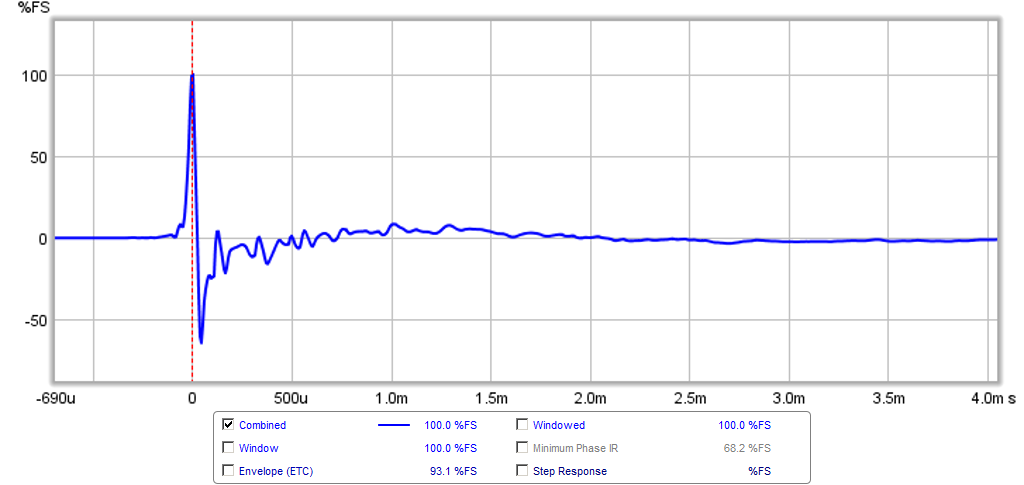
This is the measured step response:
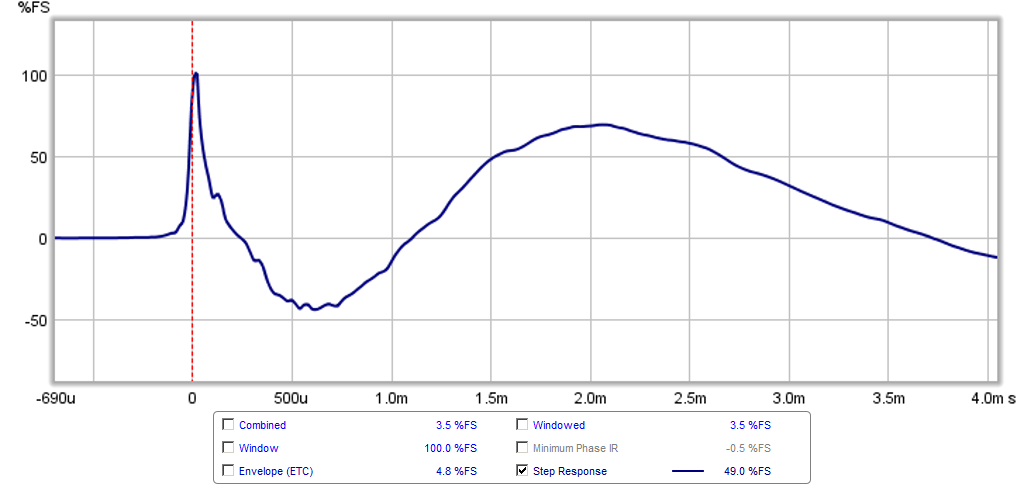
Here is the measured combined group delay and excess delay:
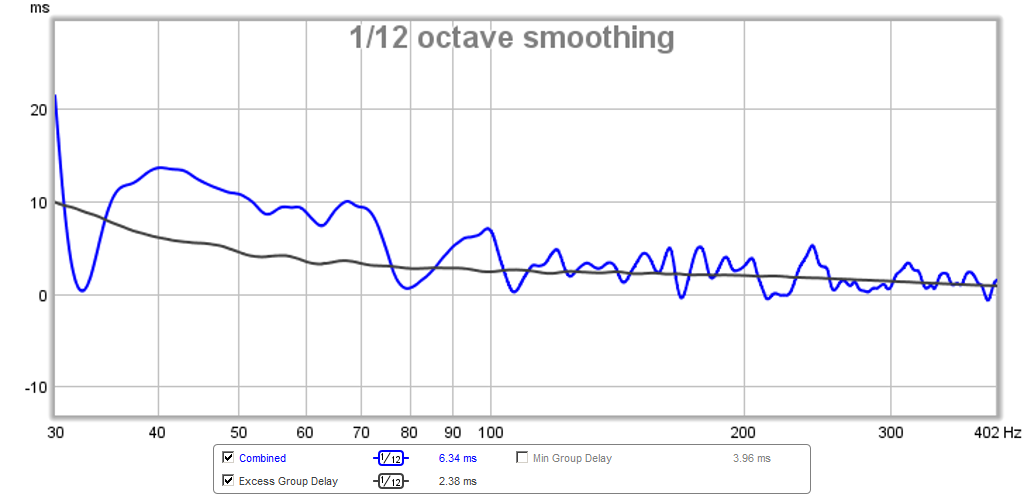
Here is the measured harmonic distortion:
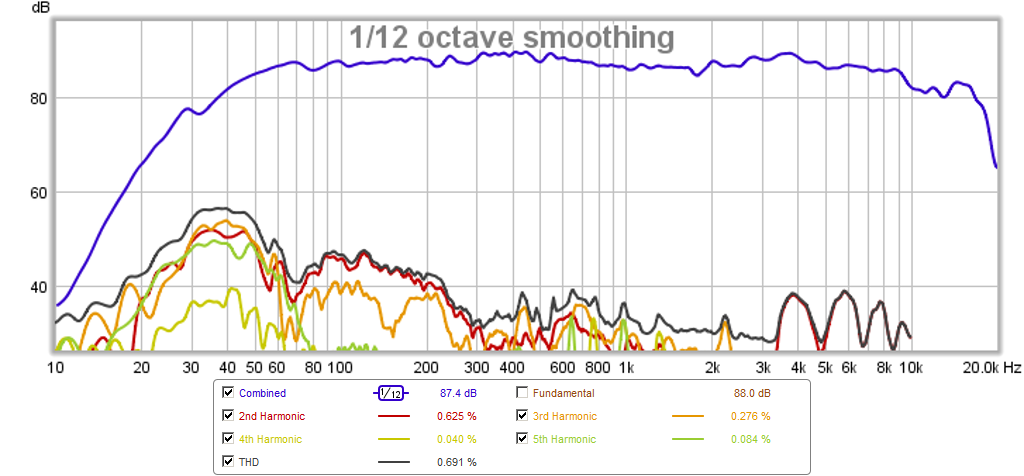
It sounds much better, more full and very balanced and even. The deeper bass extension is very welcome and the transients on percussions sound more crisp now. Vocals are velvety smooth - an excellent sounding speaker that is non-fatiguing to listen to for extended periods.
I used the miniDSP provided spreadsheet to calculate the biquad coefs for a Linkwitz transform based on the measured fb=120Hz and Q=0.71, transformed to a new f=50Hz and Q=0.71.
Here are the Linkwitz transform bi-quad coefs for the W5-876SE in a 6in edge Hypercube with moderate stuffing:
Code:
biquad1,
b0=1.0060101309256,
b1=-1.98976252026332,
b2=0.983997886960536,
a1=1.98985948330011,
a2=-0.989911054849346Here is the raw response of the woofer (blue), and with the Linkwitz transform applied (red), this is measured 2in away from the cone per the recommendation in the miniDSP instructions:

Here is the new resulting XO using a 240Hz LP on the woofer and 300Hz HP on the fullrange per the Akabak sim. Note that the -3dB point is about 43Hz which is excellent considering it was 120Hz before. The highs are little depressed since the mic was in between the TC9FD and the W5876SE at 8in away so it's a little off axis:

Here is the corresponding measured minimum phase:

This is the measured impulse response:

This is the measured step response:

Here is the measured combined group delay and excess delay:

Here is the measured harmonic distortion:

It sounds much better, more full and very balanced and even. The deeper bass extension is very welcome and the transients on percussions sound more crisp now. Vocals are velvety smooth - an excellent sounding speaker that is non-fatiguing to listen to for extended periods.
Attachments
-
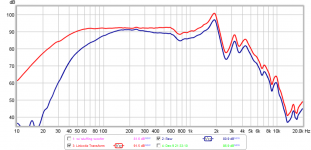 fast-hypercube-linkwitz-transform.png81.9 KB · Views: 682
fast-hypercube-linkwitz-transform.png81.9 KB · Views: 682 -
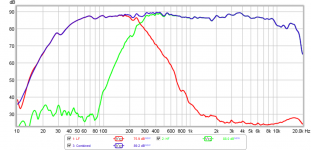 hyperfast-linkwitz-xo.png102.1 KB · Views: 1,560
hyperfast-linkwitz-xo.png102.1 KB · Views: 1,560 -
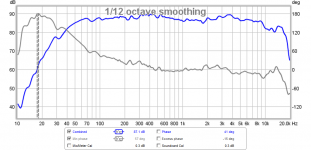 hyperfast-linkwitz-phase.png82 KB · Views: 952
hyperfast-linkwitz-phase.png82 KB · Views: 952 -
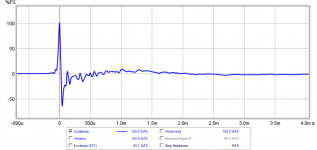 hyperfast-linkwitz-ir.png42.6 KB · Views: 1,548
hyperfast-linkwitz-ir.png42.6 KB · Views: 1,548 -
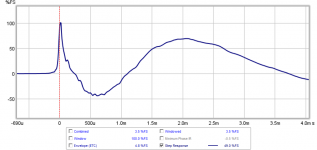 hyperfast-linkwitz-step.png46.3 KB · Views: 951
hyperfast-linkwitz-step.png46.3 KB · Views: 951 -
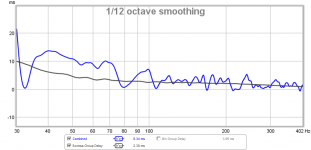 hyperfast-linkwitz-gd.png60.7 KB · Views: 1,536
hyperfast-linkwitz-gd.png60.7 KB · Views: 1,536 -
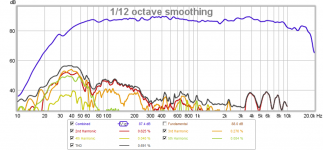 hyperfast-linkwitz-hd.png135.8 KB · Views: 644
hyperfast-linkwitz-hd.png135.8 KB · Views: 644
Last edited:
Thanks for the link on the Linkwitz transform for miniDSP. That is exactly what I needed to calculate the bi quad coefs.
Very happy to help. Boy, you work fast. I like the new measurements, particularly the phase in the lowest octaves. With my DSP, I have been experimenting for a few days now (as I have in the past with other speakers) with allowing a small amount of low freq. pre-echo in exchange for phase response that doesn't exceed 90 deg in the low end. I think this helps the lowest frequencies to seem clearer and more audible.
Gmad,
Thanks. I don't waste time if it's easy to do. I did this Linkwitz transform and took measurments in 30minutes. My trick is to always have a hot measurement mic mounted on a stand ready to go and REW running on the laptop. Then it literally takes seconds for me to take a measurement at a moment's notice. The miniDSP is so easy to work with and fast.
This is the first time I have done a Linkwitz transform. I encourage anyone with a miniDSP and a sealed sub or woofer to try it out. It is easy to do and really works if you have ample xmax.
Look at the two responses below and you can imagine how the red curve sounds compared to the raw one.

Thanks. I don't waste time if it's easy to do. I did this Linkwitz transform and took measurments in 30minutes. My trick is to always have a hot measurement mic mounted on a stand ready to go and REW running on the laptop. Then it literally takes seconds for me to take a measurement at a moment's notice. The miniDSP is so easy to work with and fast.
This is the first time I have done a Linkwitz transform. I encourage anyone with a miniDSP and a sealed sub or woofer to try it out. It is easy to do and really works if you have ample xmax.
Look at the two responses below and you can imagine how the red curve sounds compared to the raw one.

Last edited:
Nice but... Isn't it time for you to get down to 16hz for those big organ pipes? We're still waiting for that hypercube subwoofer/side-table.... 😀
xrk971,
Wow great specs you got in post 32, impulse and step response often seems at the better when running sealed.
gmad,
If linkwitz transform not available for Foobar you could try the 30 days free jRiver MC where it's build in the DSP engine one can add as many as one like and even if target for left/right is desired different then add two where the filter destination set respectively right and left. Attach example linkwitz transform in jRiver MC.
Wow great specs you got in post 32, impulse and step response often seems at the better when running sealed.
gmad,
If linkwitz transform not available for Foobar you could try the 30 days free jRiver MC where it's build in the DSP engine one can add as many as one like and even if target for left/right is desired different then add two where the filter destination set respectively right and left. Attach example linkwitz transform in jRiver MC.
Attachments
The impulse and step are mostly a function of the excellent TC9FD as the high frequencies contribute the most. Where the two-way XO comes in is how smooth the phase is in transitioning from the Vifa to the Tang Band woofer, and how the sealed cabinet shows how well it works here by providing a flat response through the XO region which really keeps excess group delay low and uniform. A bass reflex alignment would not be as smooth and have more group delay.
Oh took a update view at "Hypercube Loudspeakers" thread and realize at entertainment factor this thread has low level and is boring by not having surfboard pictures and loud voices 🙂.
Last edited:
X, an F3 of 43hz with a final qtc of .5 is tough to argue with.
BYRTT, Thanks for that tip. I do all my real time dsp via the foobar convolver plugin.
BYRTT, Thanks for that tip. I do all my real time dsp via the foobar convolver plugin.
X, an F3 of 43hz with a final qtc of .5 is tough to argue with.
BYRTT, Thanks for that tip. I do all my real time dsp via the foobar convolver plugin.
Convolver plugin, do you linear the system phase too at the cost of some real time latency. By the way xrk971 soon have same full ranger toys as your gmad, could be i'm a little envy you two, the Parts express tracking info says they arrived his local postoffice 11:27. Be exiting follow you two exchange info those drivers, and get a description how it compare TC9FD.
- Status
- Not open for further replies.
- Home
- Loudspeakers
- Full Range
- HyperFAST - a Hypercube Based 2-Way
